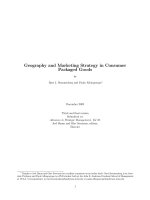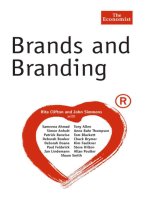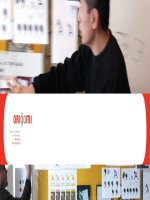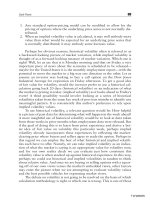8 PRODUCT, SERVICES AND BRANDING STRATEGY
Bạn đang xem bản rút gọn của tài liệu. Xem và tải ngay bản đầy đủ của tài liệu tại đây (743.67 KB, 23 trang )
8. PRODUCT, SERVICES AND BRANDING STRATEGY
Product —
Anything that can be offered to a market for
attention, acquisition, use, or consumption
that might satisfy a want or need.
COLLEGE OF BUSINESS ADMINISTRATION
CHUNG-ANG UNIVERSITY
PROF HYUNSUK SUH
2
What is the definition of “Product and Service? ”
Product and Service
Product: Anything that can be offered to a market for attention, acquisition,
use, or consumption that might satisfy a want or need. Products include more
than tangible goods. It includes physical objects, services, events, persons,
places, organizations, ideas, or mixes of these entities.
Service: It is a form of product that consist of activities, benefits, or
satisfactions offered for sale that are essentially intangible and do not
result in the ownership of anything.
Kotler and Armstrong, 2008, 2013
3
What is the definition of “Product and Service? ”
Definition: Product and Service
Product:
Everything both favorable and unfavorable that an person received in an
exchange.
Lamb, Hair, McDaniel, 2009, 2011, 2013
Good:
A good is a tangible product, something that we can see, touch, smell,
hear, taste, or possess. In contrast, intangible product-services, ideas,
people, places-are products that we can’t always see, touch, smell, taste,
or possess.
Solomon, Marshall, Stuart, 2009
Product
Product
Good
Service
Idea
Good
Service
Idea
4
The objectives of the current chapter are described below.
Objectives
Define product and understand the major classifications of products
and services
Understand the decisions people make regarding their products and
services
Identify the four characteristics that affect the marketing of a service
0. Objectives
5
Product planners need to think about products and services on three(3) levels which
each level adds more customer value.
Three(3) Levels of Product
Core Product ( 핵심제품 )
The core benefit customers want from
the product
e.g.) convenience( 편편편편편편편편편편편편편편편
편편
편편편편편편편편편 편편편편편편
automobile – safety, convenience
Actual Product ( 유형제품 )
The tangible product that can actualize
core benefit
e.g.) package( 편편편편 design편 편편편편편편편편
automobile- 편편편편편편편 engine편편
편편편편편편편편편 편편편편편 power handle편편편
편편편편편편편편편 편편편편편편편편편편편편편편편편편편편
편편
Augmented Product ( 확장제품 )
Additional service or product that assists
to purchase and use the product
e.g.) 편편편편편 warranty편편편 편편
편 exchange편편
편편편편편편편편편편 편편편편편편편편편편편편편편편편편편
편편편편
편편편편편편편편편편편 편편편편편편편편편편편편
Operational
Supported
Adviser
Channel
Core
Product
Actual Product
Augmented
Product
Brand
Name
Quality
Level
Packaging
Design
Features
Delivery
&
Credit
Installation Warranty
After-
Sale
Service
Exchange or
Refund
1. Product Definition
6
DISCUSSIONS
Consider Starbucks,
1. What is the core product that
Starbucks offer? Actual and
Augmented levels?
Consider following Starbucks example.
Starbucks
1. Product Definition
In Class Exercise
7
Classification: Consumer Products
Consumer products are products and services bought by final consumers for personal
consumption.
Customer buy frequently, immediately, and with minimum of comparison and
buying effort: Low priced, and place them in many locations for ready availability
(e.g. soap, candy, newspaper, shampoo, fast food, etc.)
Convenience
Goods
Less frequently purchased products that customers compare carefully on suitability,
quality, price, and style: Placed in fewer outlets but with deeper sales support
(e.g. furniture, clothing, cars, hotel and airline services, etc.)
Shopping
Goods
Unique characteristics or brand identification which significant group of buyers is
willing to make special purchase efforts: They are usually not compared. Buyers
only invest time needed to reach dealers who carry these items
(e.g. high-priced photographic equipment, special design clothes, Lamborghini, etc.)
Specialty
Goods
Products that the customer either does not know about, or know about but does not
normally think of buying: Most major new innovations until customer becomes aware.
They require lot of advertising and personal selling
(e.g. life insurance, cemetery plots, blood donations, etc.)
Unsought
Goods
1. Product Definition
8
Convenience Shopping Specialty Unsought
CONSUMER
ATTITUDES
PRODUCT
soda, soft drinks,
milk, toothpaste,
soap, etc.
clothing, computers,
appliances,
furniture, etc.
luxury items: Rolex,
Jaguar, etc.
medical trauma
services
PLACE
PRICE
PROMOTION
Let’s apply the classification of products to marketing mix considerations below.
Classification and Marketing Mix Consideration for Consumer Products
Low involvement,
minimize time and
effort
Moderate to high
involvement,
balance between
image and feature
Very high
involvement, image
is more important
than features
Unaware, possibly
avoiding learning
about category
Wide spread,
convenient
locations
Large number of
selective outlets
Limited and
exclusive few
outlets
More selective
outlets from few to
many - Varies
Low price
Moderate price
High price
Varies
Focus on price,
availability, and
awareness
Focus on features,
and differentiation
Focus on brand,
and status
Focus on
awareness
1. Product Definition
9
Product Attributes
Developing a product or service involves delivering the benefits of product attributes:
quality, features, and style & design.
Major positioning tool. Direct impact on P/S performance
1. Level: performance quality – ability of a product to perform its functions
Companies choose a quality level that matches with target market needs
and competing products
2. Consistency: conformance quality –freedom from defects and consistency
in quality delivery to target markets
QUALITY
Style : simply describes the appearance (look and feel to the buyer)
Design : more than skin deep. It contributes to products usefulness as well as to its
looks (e.g. men’s wet shaving world)
STYLE &
DESIGN
2. Product Attribute
10
Product Line Decisions
Beyond decisions about the individual products and services, product strategy also
calls for building a product line.
A group of products that are closely related because they may…
-function in a similar manner
-are sold to the same customer groups
-market through the same types of outlets
-fall within given price range
Product line length is influenced by company
objectives and resources
PRODUCT
LINE
11
A company’s product mix has four important dimensions: width, length, depth, and
consistency.
Different product lines company carries
(e.g. Home care, baby care, beauty care, health care, food & beverage products, etc.)
Width
Total number of items the company carries within its product lines
(e.g. 7 laundry detergents, 6 hand soaps, 5 shampoos, 4 dishwashing detergents, etc.)
Length
Number of versions offered of each product in the line
(e.g. Crest toothpaste - in 13 varieties – Crest multicare, Crest cavity protection, etc.)
Depth
Product Mix Decisions
2. Product Attribute
12
The following examples show product width and length for Proctor & Gamble
products.
Product Width and Length
Product MIX WIDTH
Product
LINE
LENGTH
Detergents
Ivory Snow
Dreft
Tide
Cheer
Oxydol
Dash
Bold
Gain
Era
Toothpaste
Gleem
Crest
Disposable
Bar Soap
Ivory
Kirk’s
Lava
Camay
Zest
Safeguard
Coast
Oil of Olay
Diapers
Pampers
Luvs
Paper
Tissue
Charmin
Puffs
Banner
Summit
DEPTH
Crest has 3 sizes and 2
formulations
Crest
2. Product Attribute
Example
13
2. Product Attribute
The following example of BMW website applies the concepts of product line width,
length, and depth.
BMW: Product Width and Length
Example
14
Brand Positioning
Marketers need to position their brands clearly in target customers’ mind by adjusting
any of the following three(3) levels.
- Product attributes (e.g. Dove soap-one quarter cleaning cream)
ATTRIBUTES
- Brand can be better positioned by associating its name with a desirable benefit
(e.g. Dove soap-softer skin)
BENEFITS
- The strongest brands that go beyond attribute or benefit positioning
(e.g. How those cleansing cream attributes and softer skin benefits will
make you more attractive)
BELIEFS
&
VALUES
3. Brand
15
Companies are realizing the power of good packaging to create instant customer
recognition of the company or brand.
Types of Packaging
Product’s primary container
(e.g. The tube holding Colgate toothpaste)
Primary
container
Secondary package is thrown away when the product is about to be used
(e.g. The cardboard box containing tube of Colgate)
Secondary
package
Shipping package necessary to store, identify, and ship the product
(e.g. a corrugated box carrying six(6) dozen tubes of Colgate)
Shipping
package
Packaging Facts
•
The power of good packaging create instant customer recognition of the company or brand
•
Innovative packaging can give a company an advantage over competitors
•
Packaging decision includes size, shape, materials, color, text, and brand mark
•
Recent years the “product safety” become a major package concern (e.g. childproof drugs)
•
Go Green! - environmentally responsible packaging materials
4. Packaging
16
Labeling - printed information appearing on or with the package - is also part of the
package.
Functions of Labeling
It identifies the product or brand
(e.g. Sunkist stamped on an orange)
Identifies
Describes several things
(e.g. where it was made, when it was made, contents, how it is to be used, and safey)
Describes
Texts and graphics
Promotes
Label contains
Stating the price per unit of standard measure
Unit price
Nutritional value of the product (e.g. calories, fats, proteins, etc.)
Nutrition
Manufactured date, expiration date
Date
5. Labeling
17
What is a service? The distinction between goods and services is not always perfectly
clear. In fact, providing an example of a pure good or a pure service is very difficult.
Goods and Services
6. Service
GOODS
Objects, Devices, or things
SERVICES
Deeds, efforts, or performances
PRODUCTS
Scale of Market Entities: The Scale that displays a range of products along a continuum
based on their tangibility
18
The following “Molecular Model” further expand our understanding of the basic
differences between goods and services.
The Molecular Model
6. Service
19
Meaning
Intangibility
Inseparability
Variability
Perishability
Services
The four characteristics of service is described below.
Four(4) Service Characteristics
Intangibility:
Services can not be seen, tasted, felt, heard,
or smelled before they are bought
Variability:
Quality of service depends on who provides
them as well as when, where, and how they
are provided
Inseparability:
Services cannot be separated from their
providers, whether the providers are people
or machines
Perishability:
Service cannot be stored for later sales or
use
6. Service
20
Intangibility is a distinguishing characteristic of services that makes them unable to be
touched or sensed in the same manner as physical goods.
Intangibility
6. Service
Marketing Problems Possible Solutions
Lack of service inventories Use of tangible clues
Difficulty in displaying or
communicating services
Creation of a strong organizational
image
Difficulty in pricing strategies
21
Service providers are often in constant contact with their customers and must
construct their service operations with the customer’s physical presence in mind. This
interaction represent greatest opportunity for both gains and losses in regard to
customer satisfaction and retention.
Inseparability
6. Service
Marketing Problems Possible Solutions
Physical connection of the service
provider to the service
Selecting and training public contact
personnel
Involvement of the customer in the
production process
Consumer management
Involvement of other customers in the
production process
Use of multisite location
22
Variability or heterogeneity is the variation in consistency from one service transaction
to the next. If something goes wrong or come up during the service process, it is too
late to institute quality control measures before the service reaches the customer.
Variability (Heterogeneity)
6. Service
Marketing Problems Possible Solutions
Difficult to standardize service and
quality control
Customization / Standardization
23
Perishability refers to the fact that services can not be saved, their unused capacity
can not be reserved, and they can not be inventoried.
Perishability
6. Service
Marketing Problems Possible Solutions
Higher demand than maximum
available supply
Demand strategy: Creative pricing
Reservation systems
Higher demand than optimal supply
level
Development of complementary
services
Lower demand than optimal supply
level
Development of nonpeak demand









